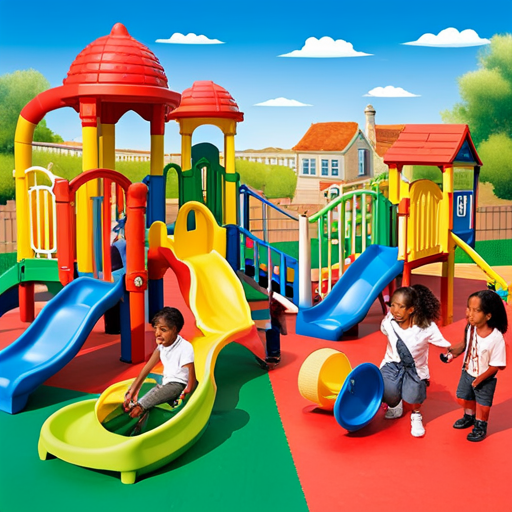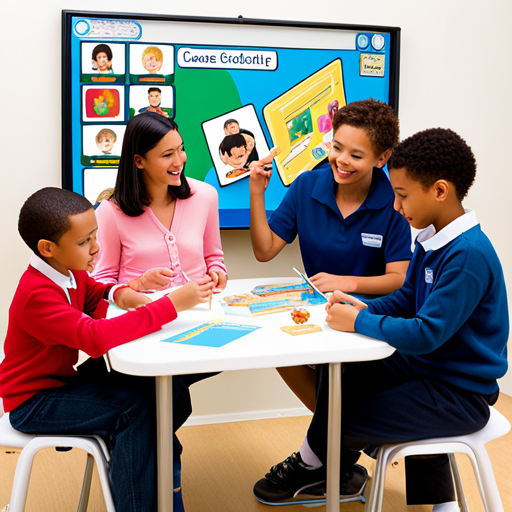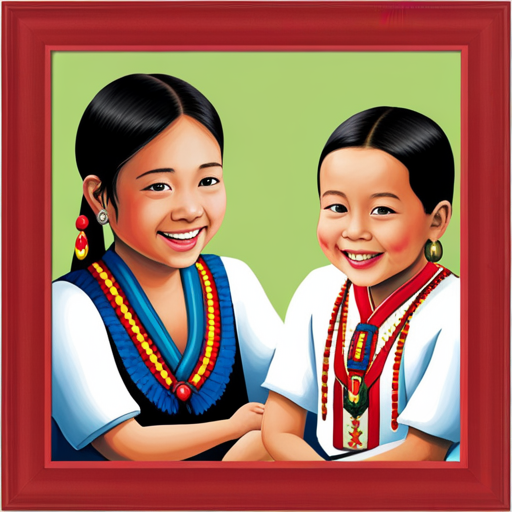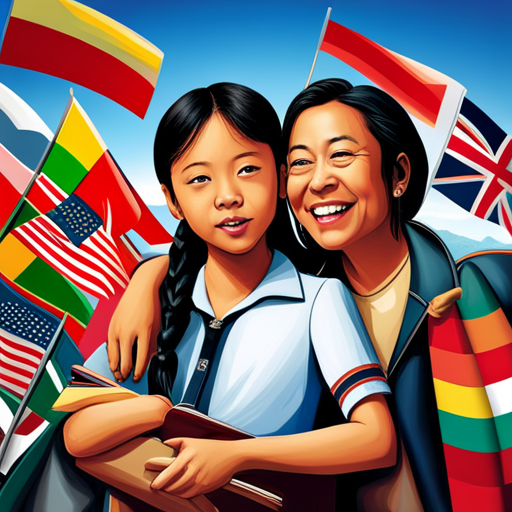"Cherishing Little Steps - A Haven for Baby and Family Journeys"
Raising Bilingual Children
You’re embarking on a beautiful journey, one that will enrich your child’s life in ways you can’t even imagine. Raising bilingual children is an incredible opportunity to open doors and broaden horizons. It’s like giving them a secret superpower, a gift that will stay with them forever.
In this guide, we’ll explore the benefits of bilingualism, share best practices for starting early, and provide tips for creating a language-rich environment at home. We’ll also help you navigate the challenges of balancing multiple languages and embracing cultural identity.
Whether you speak one language or several, this resource is designed to support and empower you on this amazing adventure of raising bilingual children. Let’s get started!
Key Takeaways
- Early exposure to multiple languages is beneficial for children as it enhances their cognitive abilities and problem-solving skills.
- Creating a language-rich environment at home by introducing books, music, and videos in both languages is important for bilingual children’s language development.
- Choosing the right language strategy involves considering the child’s unique needs and goals, exploring language immersion programs, and consulting with language experts or other bilingual parents.
- Nurturing language development at home can be done by consistently speaking the target language with the child, reading aloud in the target language, and creating a supportive environment for language practice.
Benefits of Bilingualism

Raising bilingual children can offer numerous advantages, such as increased cognitive abilities, improved problem-solving skills, and enhanced cultural awareness. When children are exposed to multiple languages from an early age, their brains develop the ability to think flexibly and switch between languages effortlessly. This cognitive flexibility not only strengthens their language skills but also enhances their overall cognitive abilities. Studies have shown that bilingual children have better attention control, memory skills, and problem-solving capabilities compared to monolingual children.
One of the cognitive benefits of bilingualism is a stronger executive function. This refers to a set of mental processes that help us manage our thoughts, actions, and emotions. Bilingual children often exhibit better self-control, decision-making skills, and the ability to switch between tasks seamlessly. These skills have a positive impact on academic performance and future success.
Additionally, being bilingual fosters a deeper understanding and appreciation of different cultures. When children learn multiple languages, they gain insights into the customs, traditions, and values of different communities. This exposure broadens their perspective, promotes empathy, and enables them to navigate diverse social settings with ease.
Starting Early: Best Practices
To ensure the successful development of bilingualism in your child, it’s important to start early and establish best practices. Early exposure to multiple languages is crucial in helping your child become fluent in both. Research has shown that children have a natural ability to absorb languages at a young age, so it’s essential to take advantage of this window of opportunity.
One effective method is language immersion, where your child is surrounded by the target language. This can be achieved by enrolling them in a bilingual school or hiring a bilingual nanny. Immersion allows your child to hear and use the language in real-life situations, accelerating their language acquisition.
Creating a language-rich environment at home is also key. Introduce books, music, and videos in both languages. Engage in activities that encourage language learning, such as playing games, singing songs, or watching movies together. Encourage your child to speak in both languages and provide positive reinforcement when they do.
Consistency is vital when it comes to bilingualism. Make sure to establish a routine that incorporates both languages and stick to it. Consistency reinforces language learning and helps your child develop strong language skills in both languages.
Starting early and implementing these best practices will give your child a solid foundation in bilingualism and set them up for success in their language journey. So, seize the opportunity and embark on this bilingual adventure with your child!
Building a Language-Rich Environment
To build a language-rich environment for your child, it’s important to incorporate language learning into everyday activities. By providing consistent language exposure and creating a language immersion environment, you can greatly enhance your child’s language development. Here are four practical ways to create a language-rich environment:
-
Speak the target language: Make a conscious effort to speak the target language with your child as much as possible. This will help them become familiar with the sounds, vocabulary, and grammar of the language.
-
Read books: Read books in the target language to your child regularly. This not only exposes them to new words and sentence structures but also fosters a love for reading and language learning.
-
Play language games: Incorporate language learning into playtime by playing games that require your child to use the target language. This could include word matching games, memory games, or even simple conversations.
-
Use multimedia resources: Utilize multimedia resources such as songs, videos, and interactive apps that provide exposure to the target language. This can make language learning fun and engaging for your child.
Choosing the Right Language Strategy

To choose the right language strategy for your bilingual child, it’s important to consider their unique needs and goals. When it comes to teaching methods, one popular approach is language immersion. This method involves surrounding your child with a particular language, whether it be at home, school, or through cultural activities.
By immersing your child in the language, they’re constantly exposed to it and are more likely to develop fluency. Language immersion programs are available in many countries and can vary in intensity and duration. Some programs offer full immersion, where all instruction is conducted in the target language, while others offer partial immersion, with a combination of the target language and the native language.
When choosing a language strategy, it’s important to consider your child’s preferences and learning style. Some children thrive in a total immersion environment, while others may prefer a more gradual approach. It can be helpful to consult with language experts or other parents who’ve raised bilingual children to gain insights and advice.
Nurturing Language Development at Home
Create a language-rich environment at home to nurture your child’s language development. Here are four practical tips to help you create a nurturing language-learning environment for your child:
-
Speak the target language: Consistently communicate with your child in the language you want them to learn. Be their model and speak to them in full sentences, using correct grammar and vocabulary.
-
Read aloud: Make reading a daily routine in your home. Read books, magazines, and even labels together. Encourage your child to ask questions and engage in discussions about the stories or topics.
-
Play games: Incorporate language learning into playtime. Play word games, memory games, or even create your own language-based activities. This will make language learning fun and interactive.
-
Expose your child to the culture: Language and culture go hand in hand. Expose your child to the culture associated with the language they’re learning. Watch movies, listen to music, cook traditional dishes, and celebrate holidays from the target culture.
Fostering Language Skills in School

In school, you can further enhance your child’s language skills through collaborative activities and exposure to diverse linguistic experiences. One effective way to foster language skills is through language immersion programs. These programs provide an immersive environment where your child is surrounded by native speakers of the target language. By being exposed to the language on a daily basis, your child will develop their listening, speaking, reading, and writing skills naturally.
Another option is enrolling your child in a bilingual curriculum. This type of program offers instruction in two languages, allowing your child to become proficient in both. The curriculum is designed to integrate language learning into various subjects, making it a seamless process. Through this approach, your child will not only gain language skills but also develop a deeper understanding of different cultures and perspectives.
To give you a clearer picture, here’s a table outlining the benefits of language immersion and bilingual curriculum:
| Language Immersion | Bilingual Curriculum |
|---|---|
| Provides immersion in the target language | Offers instruction in two languages |
| Develops listening, speaking, reading, and writing skills naturally | Integrates language learning into various subjects |
| Enhances cultural understanding | Deepens cultural understanding and perspective |
Overcoming Challenges: Consistency and Motivation
One challenge you may face when raising bilingual children is maintaining consistency and motivation. It can be difficult to stay on track and keep your children motivated to learn and use both languages. However, with the right strategies, you can overcome these challenges and create a positive bilingual environment for your children.
Here are four effective strategies to help you maintain consistency and motivation:
-
Establish a routine: Set aside dedicated time for language learning every day. This could be reading books, playing games, or having conversations in both languages. Consistency is key in reinforcing language skills.
-
Make it fun: Find creative ways to make language learning enjoyable. Use music, videos, and interactive activities to engage your children. Incorporate cultural elements and celebrate milestones to keep them motivated.
-
Provide real-life opportunities: Encourage your children to interact with native speakers or join language clubs. Exposing them to authentic language experiences will enhance their motivation and help them see the practical benefits of bilingualism.
-
Be a role model: Show enthusiasm for language learning yourself. Speak both languages consistently and encourage your children to do the same. Your commitment and passion will inspire and motivate them to embrace bilingualism.
Balancing Multiple Languages

To maintain a balanced approach when raising bilingual children, it is crucial to navigate the challenge of managing multiple languages effectively. Balancing multiple languages can be a complex task, but with proper strategies, it can become a seamless part of your child’s language development journey.
One effective approach is language immersion, where each language is given dedicated time and space. This can be done by setting aside specific activities or days of the week for each language. For example, you can designate Mondays for English and Tuesdays for Spanish. This helps create a sense of structure and consistency for your child.
Another approach is bilingual education, where both languages are integrated into your child’s daily life and learning experiences. This can be achieved through attending bilingual schools or enrolling in language immersion programs. These opportunities provide your child with the chance to interact with peers who are also bilingual, fostering a supportive language environment.
Here is a table that highlights different strategies for balancing multiple languages effectively:
| Strategy | Benefits |
|---|---|
| Language immersion | Develops strong language skills in each language |
| Bilingual education | Provides a supportive language environment |
| Cultural activities | Enhances cultural understanding and appreciation |
Embracing Cultural Identity

To fully embrace your child’s cultural identity while raising them bilingual, it’s important to celebrate and incorporate their heritage into their daily lives. Embracing cultural identity not only helps your child feel connected to their roots, but also enhances their language learning experience. Here are four practical ways to celebrate and preserve cultural identity while raising bilingual children:
-
Cultural celebrations: Participate in cultural festivals, holidays, and traditions from your child’s heritage. This can include cooking traditional meals together, dressing up in cultural attire, or attending cultural events. These celebrations provide opportunities for your child to learn about their cultural heritage and develop a sense of pride in their identity.
-
Language preservation: Encourage the use of the heritage language at home by speaking it regularly and exposing your child to native speakers. Create a language-rich environment by reading books, watching movies, and listening to music in the heritage language. This not only helps your child maintain their language skills but also fosters a deeper connection to their cultural background.
-
Cultural artifacts: Surround your child with cultural artifacts, such as artwork, photographs, or traditional crafts. These visual reminders of their heritage can spark conversations and curiosity about their cultural background.
-
Cultural connections: Foster connections with the community of your child’s heritage. This can be through joining cultural clubs, attending cultural events, or seeking out cultural mentors. These connections provide your child with a sense of belonging and a broader understanding of their cultural identity.
Resources for Bilingual Families

To support your journey in raising bilingual children and provide assistance to bilingual families, there are various resources available. These resources can be valuable tools in helping your children develop and maintain their language skills.
One such resource is language learning apps. These apps are designed to make language learning fun and interactive for children. They offer a wide range of activities, games, and exercises that can help your child practice their language skills in an engaging way. Some popular language learning apps for children include Duolingo, Babbel Kids, and Rosetta Stone Kids.
Another resource that can be beneficial for bilingual families is bilingual storybooks. These storybooks are written in two languages, allowing your child to read and enjoy stories in both languages. Not only do they help improve your child’s language skills, but they also expose them to different cultures and traditions. Some popular bilingual storybooks include ‘The Very Hungry Caterpillar’ by Eric Carle and ‘Where the Wild Things Are’ by Maurice Sendak.
By utilizing language learning apps and bilingual storybooks, you can provide your children with the tools they need to become proficient in both languages. These resources encourage language development, cultural understanding, and a love for learning.
Celebrating Bilingual Achievement

Celebrate your children’s bilingual achievement with pride and joy. Being bilingual is an incredible accomplishment that opens up a world of opportunities for your little ones.
Here are four ways you can celebrate and encourage their bilingual journey:
-
Throw a Language Celebration: Organize a special event to honor your children’s progress in their second language. Invite family and friends who support their bilingual education. Let your children showcase their language skills through songs, poems, or storytelling. It’s a fantastic way for them to feel proud of their achievements and receive positive reinforcement from loved ones.
-
Create a Language Corner: Designate a special space in your home where your children can engage in activities related to their second language. Fill it with books, games, and other resources that support their language learning. This language corner will serve as a constant reminder of their bilingual journey and provide a dedicated space for them to practice and explore their multicultural communication skills.
-
Share Language Success Stories: Encourage your children to share their language successes with others. Whether it’s through a school presentation, a blog post, or a video, let them showcase their progress and inspire others to embrace bilingualism. By sharing their experiences, they not only celebrate their achievements but also become advocates for bilingual education.
-
Embrace Multicultural Traditions: Celebrate the diverse cultures and traditions associated with your children’s languages. Participate in cultural events, cook traditional dishes, and learn about the customs and practices of different communities. By embracing multiculturalism, you reinforce the value of their bilingualism and create a sense of pride in their heritage.
Frequently Asked Questions
How Can I Encourage My Child to Speak Both Languages Equally at Home?
To encourage your child to speak both languages equally at home, make language play fun by using games and songs. Expose them to the cultures associated with each language through food, music, and stories.
What Are Some Effective Ways to Expose My Child to Both Languages if I Am the Only Bilingual Parent?
To expose your child to both languages effectively, try incorporating engaging activities like reading bilingual books, watching educational videos, and playing language-learning games. Consistency and creativity can cultivate their language exposure and fluency.
Are There Any Negative Effects of Bilingualism on a Child’s Language Development?
Bilingualism doesn’t have negative effects on your child’s language development. In fact, it can enhance cognitive skills and improve social development. Embrace their bilingual journey and watch them flourish!
Should I Be Concerned if My Child Mixes Words or Grammar Rules From Both Languages?
Don’t worry if your child mixes words or grammar rules from both languages. It’s a normal part of bilingual development, not language confusion. To help them, encourage exposure to both languages and provide opportunities for practice in each.
How Can I Help My Child Maintain Their Bilingualism as They Grow Older and Face More Pressure to Use Only One Language?
You can help your child maintain their bilingualism by immersing them in language programs and highlighting the cognitive benefits of being bilingual. Encourage them to embrace both languages and navigate the pressure to use only one.
Conclusion
Congratulations on your decision to raise bilingual children! Research shows that bilingualism has numerous benefits, one of which is enhanced cognitive abilities.
In fact, a study conducted by the University of Edinburgh found that bilingual individuals are better at multitasking and problem-solving.
By creating a language-rich environment, nurturing language development at home, and embracing cultural identity, you’re giving your children a valuable gift that will benefit them throughout their lives.
So keep up the great work and celebrate their bilingual achievement!


